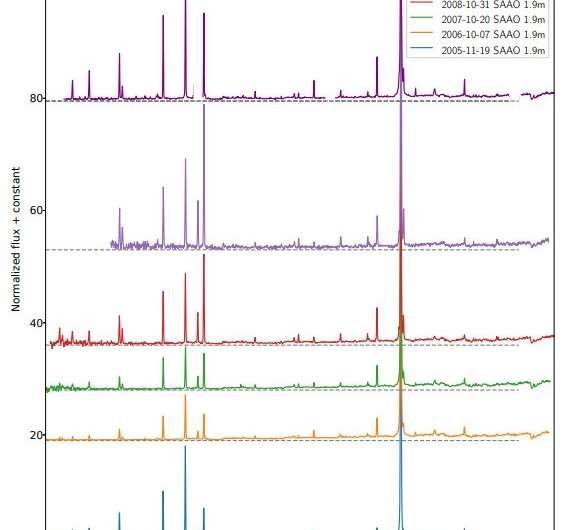February 21, 2019 report
LMC S154 is a symbiotic recurrent nova, study suggests

Astronomers have conducted observations of a symbiotic star in the Large Magellanic Cloud (LMC), known as LMC S154, which provide new insights about the nature of this object. Results of these observations, presented in a paper published February 7 on arXiv.org, suggest that LMC S154 is a symbiotic recurrent nova—the first such object identified in Magellanic Clouds.
Symbiotic stars (SySts) are in general long-period interacting binaries consisting of an evolved giant transferring mass to a hot compact object – usually a late-sequence red giant providing material to a white dwarf. One type of SySts are symbiotic novae (SyNe) in which white dwarfs experience thermonuclear explosions on their surface. When these outburst occur in SyNe more than once, astronomers classify such objects as symbiotic recurrent novae (SyRNe).
SyRNe are extremely rare and to date only four objects of this subclass have been detected. One potential candidate for a new SyRN is LMC S154, an X-ray source in the LMC classified as an SySt. Although previous studies of LMC S154 show that its variability resembles that of symbiotic novae, its SyNe status still remains unconfirmed. This is mainly due to the significant gap in photometric observations of LMC S154 ranging from 1950s to 1980s, and also due to lack of studies of this source in its quiescence.
In order to clarify the nature of LMC S154, a group of astronomers led by Krystian Iłkiewicz of Nicolaus Copernicus Astronomical Center in Poland has conducted photometric and spectroscopic monitoring of this binary with the main aim of determining the timescales of its variability. Results from this observational campaign and analysis of archival data allowed the scientists to identify with the most confidence three outbursts from the studied object.
"In this work, we study the possible evidence for the nova outburst of LMC S154. (…) The data indicate that most probably, there were three outbursts observed in LMC S154, which would make this system a member of a rare class of symbiotic recurrent novae," the researchers wrote in the paper.
According to the study, archival data, mainly carbon abundance in the photosphere of the red giant as well as luminosity and temperature changes of the white dwarf, confirm that the variability of LMC S154 is due to a classical nova outburst. Additionally, new observations show that the outburst ended in 2009, the system reached its quiescent state, and that all phases of the outburst were observed. This proves that the binary is, indeed, a symbiotic nova.
Furthermore, analysis of archival data suggests that there has been more than one outburst recorded in the history of the system. This assumption is based on the detection of doubly ionized oxygen lines between the two observed maxima in the 1940s and in the 1980s, and their the non-detection in the 1980s.
"These lines are characteristic of the nebular phase of outburst, and once detected, they last until the end of outburst, even if more than one maximum of the outburst is present (see e.g., RX Pup). This means that the maxima detected in the 1940s and the 1980s were associated with two different outbursts, and that each of them was followed by a nebular phase," the researchers explained.
They added that the detection of iron coronal lines and the observed X-ray radiation in the archival data from 1980s also support the hypothesis that LMC S154 is a SyRNe. If the theory presented in the paper is true, it would make LMC S154 the first SyRN in Magellanic Clouds and in general the third recurrent nova in the LMC.
More information: Krystian Ilkiewicz et al. LMC S154: the first Magellanic symbiotic recurrent nova. arXiv:1902.02621 [astro-ph.SR]. arxiv.org/abs/1902.02621
© 2019 Science X Network





















